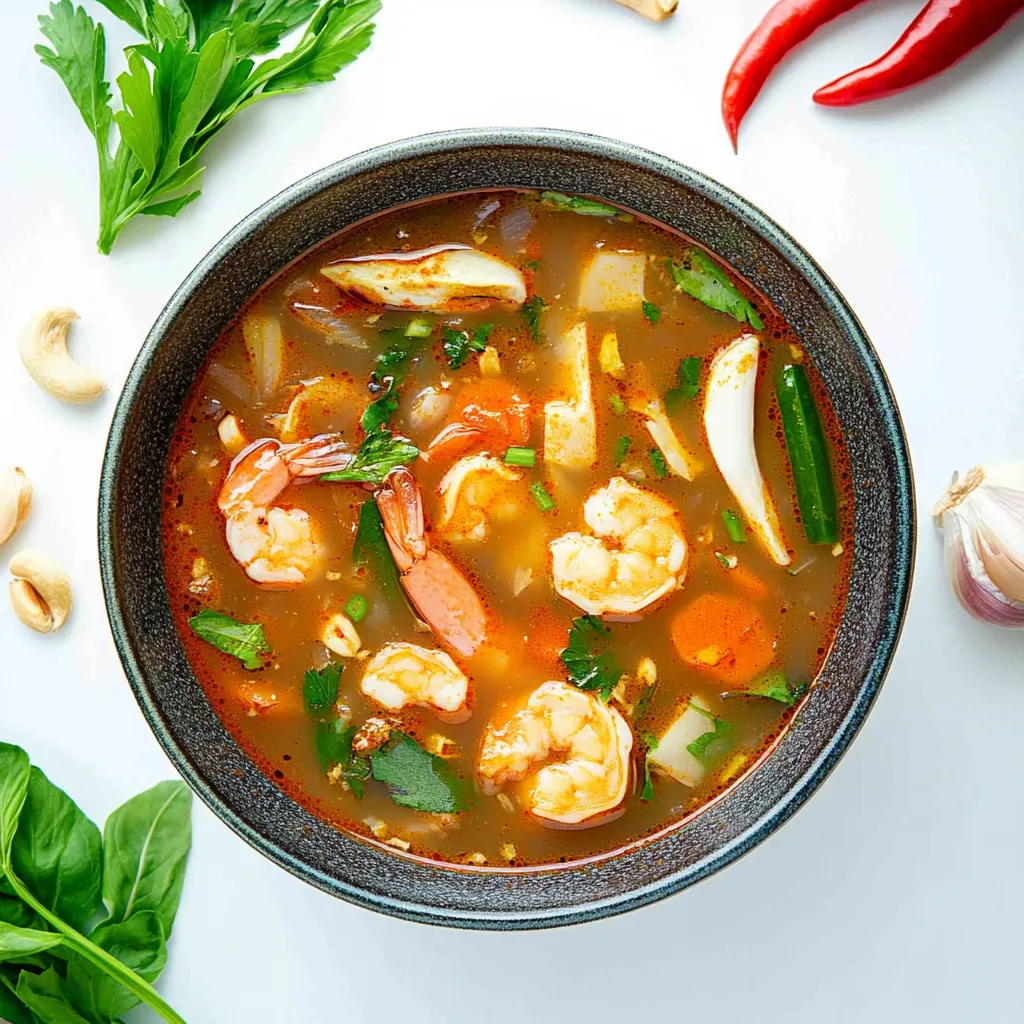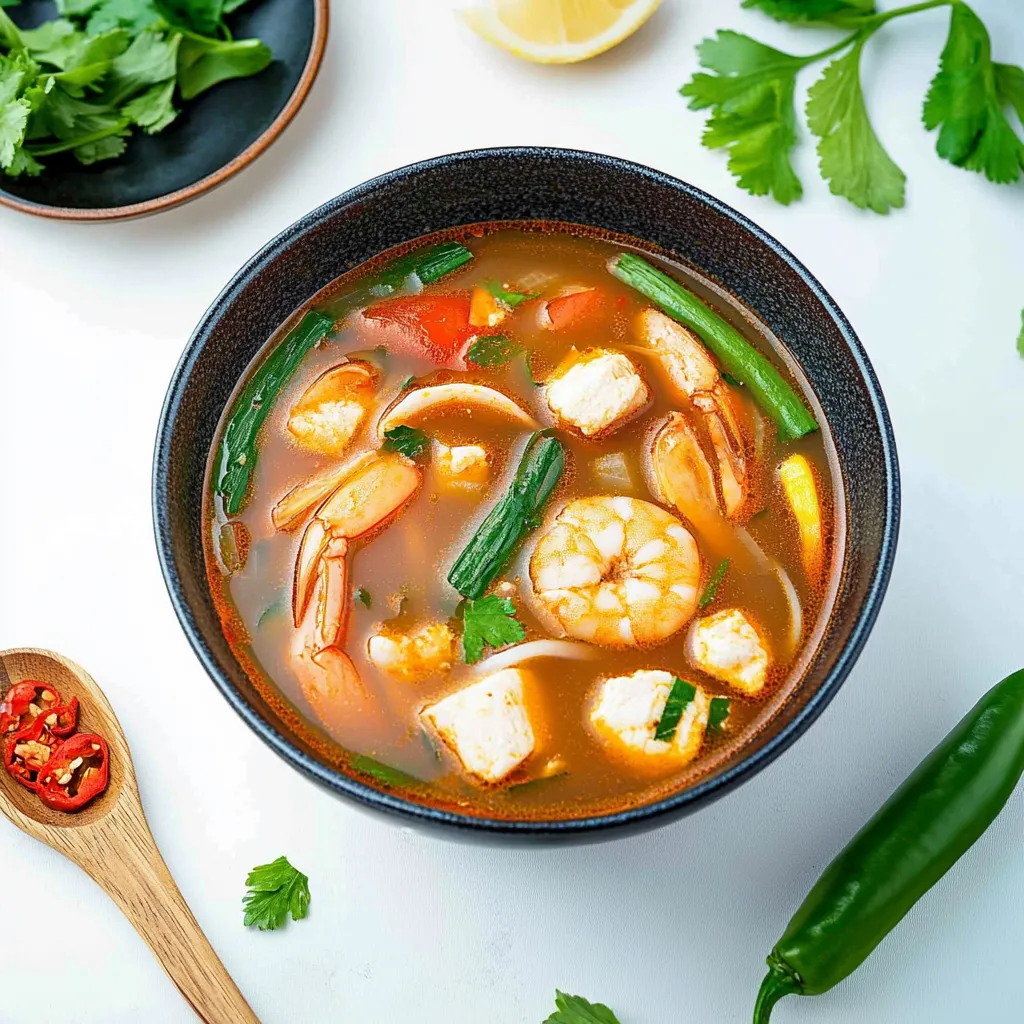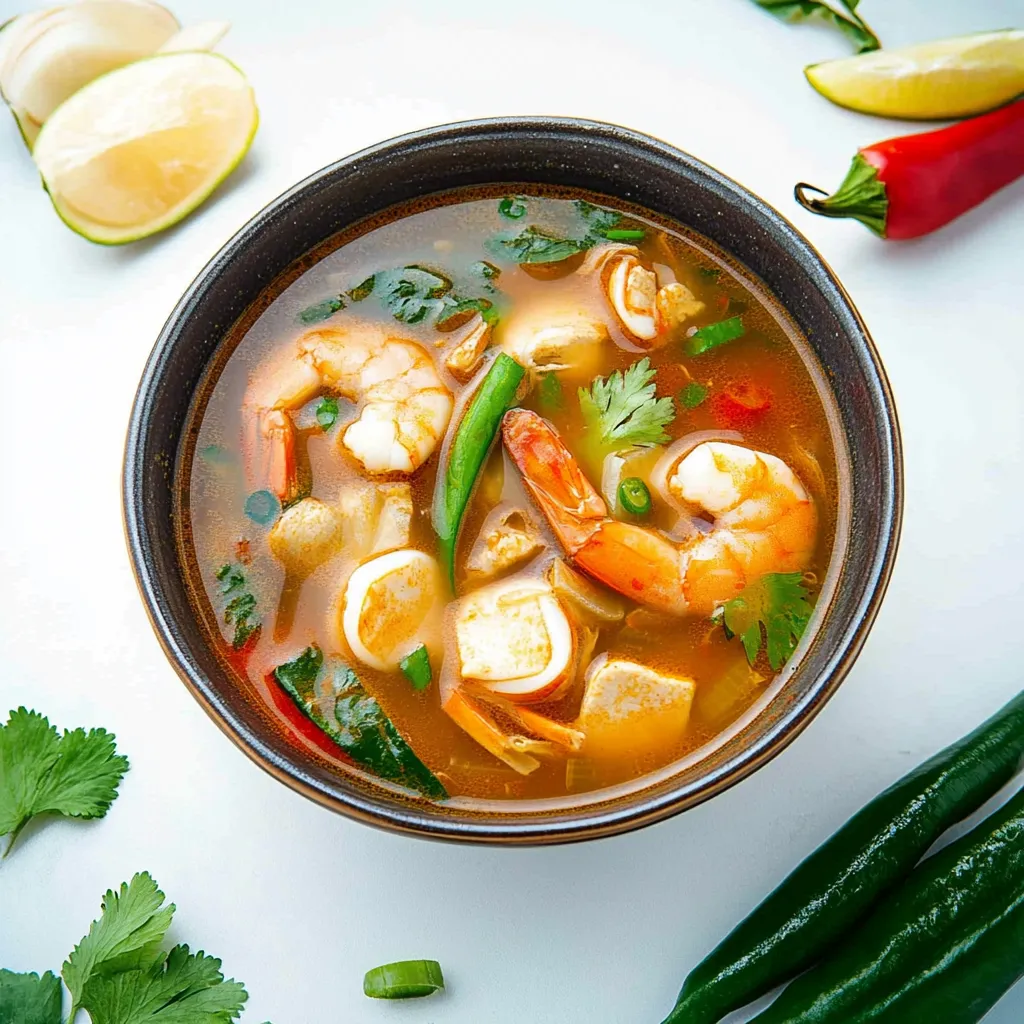 Pin it
Pin it
Picture standing over a steaming pot of Tom Yum soup, where waves of citrus-scented steam rise from a crystal-clear broth tinted with vibrant orange shrimp oil. This iconic Thai soup balances the sharp citrus notes of lemongrass and kaffir lime leaves with the gentle heat of bird's eye chilies, all while tender shrimp and mushrooms provide a satisfying depth. Each spoonful delivers a perfect harmony of hot, sour, and savory flavors that dance on your tongue and warm your soul.
My journey with Tom Yum began in a small Bangkok kitchen, where an elderly Thai chef showed me how the magic lies in respecting each ingredient's role. She taught me that rushing the shrimp oil or skipping the bruising of aromatics would result in a flat, one-dimensional soup. After countless attempts to perfect her technique, I've learned that patience with the preparation of each component creates a soup that tells the story of Thailand in every spoonful.
Essential Components
- Fresh lemongrass stalks: Should be firm and fragrant, look for tightly wrapped leaves and a lemony aroma when scratched
- Kaffir lime leaves: Must be glossy and dark green, releasing their oils when gently crushed
- Whole raw shrimp with heads attached: Provide the foundation for the rich orange oil that defines authentic Tom Yum
- Thai bird's eye chilies: Should be bright red and firm, their heat level varies, so adjust quantity to taste
- Galangal: Its woody, spicy notes cannot be substituted with ginger, look for firm, smooth skin
- Fresh limes: Provide the crucial sour element, avoid bottled juice as it lacks the brightness needed
Shrimp Oil Magic
Extract maximum flavor by gently heating shrimp heads in neutral oil over medium heat, stirring occasionally until they transform from grey to deep red. Watch for the moment when the shells become crispy and the oil takes on a rich orange hue, this indicates the essential oils and flavors have been properly released. Strain carefully, preserving every drop of the precious oil that will give your soup its signature color and depth.
 Pin it
Pin it
Aromatic Base
Prepare each aromatic with intention, trim lemongrass to remove tough outer layers, then slice and bruise to release essential oils. Tear kaffir lime leaves along their spine to release their fragrance. Slice galangal thin enough to release flavor but large enough to easily remove later. Layer these ingredients in your pot, allowing their aromas to meld together as they heat.
Broth Building
Begin with cold water and bring it slowly to temperature with your aromatics, allowing gentle bubbles rather than a rolling boil. This slow approach prevents bitterness while extracting maximum flavor. Watch as the clear broth gradually takes on a slight golden tint from the infused spices and aromatics. This stage typically takes 10-15 minutes, resist the urge to rush it.
Perfect Timing
Introduce each component in careful sequence. Start with mushrooms, allowing them 2-3 minutes to absorb the fragrant broth. Add shrimp only when the soup has reached a gentle simmer, as aggressive boiling will toughen them. Watch closely, the moment they turn from grey to pink, usually within 45 seconds, they're done.
Final Balance
This crucial step requires attention to detail. Add fresh lime juice gradually, tasting after each addition. Drizzle in the reserved shrimp oil, watching as orange droplets create beautiful patterns on the surface. Taste and adjust with fish sauce for saltiness, lime for sourness, and chilies for heat until you achieve that perfect Tom Yum harmony.
Growing up near a Thai community taught me the importance of respecting traditional preparation methods. While helping at local food festivals, I noticed how the most celebrated Tom Yum always came from kitchens that took time with the shrimp oil and never rushed the broth development. The difference in depth and complexity was remarkable.
Perfect Pairings
Transform this soup into a complete Thai feast by serving it alongside jasmine rice that can soak up the flavorful broth. Add crispy spring rolls for textural contrast, or serve before a main course of Pad Thai. For a lighter meal, pair with som tam (green papaya salad) dressed with fish sauce and lime, allowing the fresh flavors to complement the soup's intensity.
Creative Variations
Adapt this classic recipe while maintaining its soul. For a richer version, add coconut milk in the final minutes, creating Tom Yum Goong Nam Khon. Replace shrimp with mixed seafood - mussels, squid, and firm white fish each bring their own character to the broth. For a vegetarian adaptation, use mushroom-based stock and add extra varieties of mushrooms like enoki and king oyster for texture and depth.
Storage Mastery
Store components separately to maintain integrity - keep the broth in an airtight container, removing any remaining aromatics to prevent bitterness. Store cooked shrimp separately to prevent overcooking when reheating. The broth can be refrigerated for up to three days; reheat gently and add fresh lime juice just before serving.
 Pin it
Pin it
This soup represents the heart of Thai cuisine - complex yet balanced, bold yet refined. The combination of aromatic herbs, spicy chilies, and sweet shrimp creates a dish that's both comforting and exciting. Whether you're fighting a cold or craving authentic Thai flavors, this recipe delivers the true essence of Tom Yum Goong.
Frequently Asked Questions
- → Can I find kaffir lime leaves easily?
- Look in Asian markets or use dried/frozen leaves. If unavailable, use lime zest as a substitute.
- → Can I skip making the shrimp oil?
- While possible, the shrimp oil adds significant depth and authentic flavor to the soup.
- → How spicy is this soup?
- Adjust the number of Thai chilies or amount of chili paste to control the heat level.
- → Can I use peeled shrimp instead?
- Yes, but the heads and shells add significant flavor to the broth.
- → Is coconut milk traditional in Tom Yum?
- The creamy version (Tom Yum Nam Khon) includes coconut milk, but the clear version is more common.
